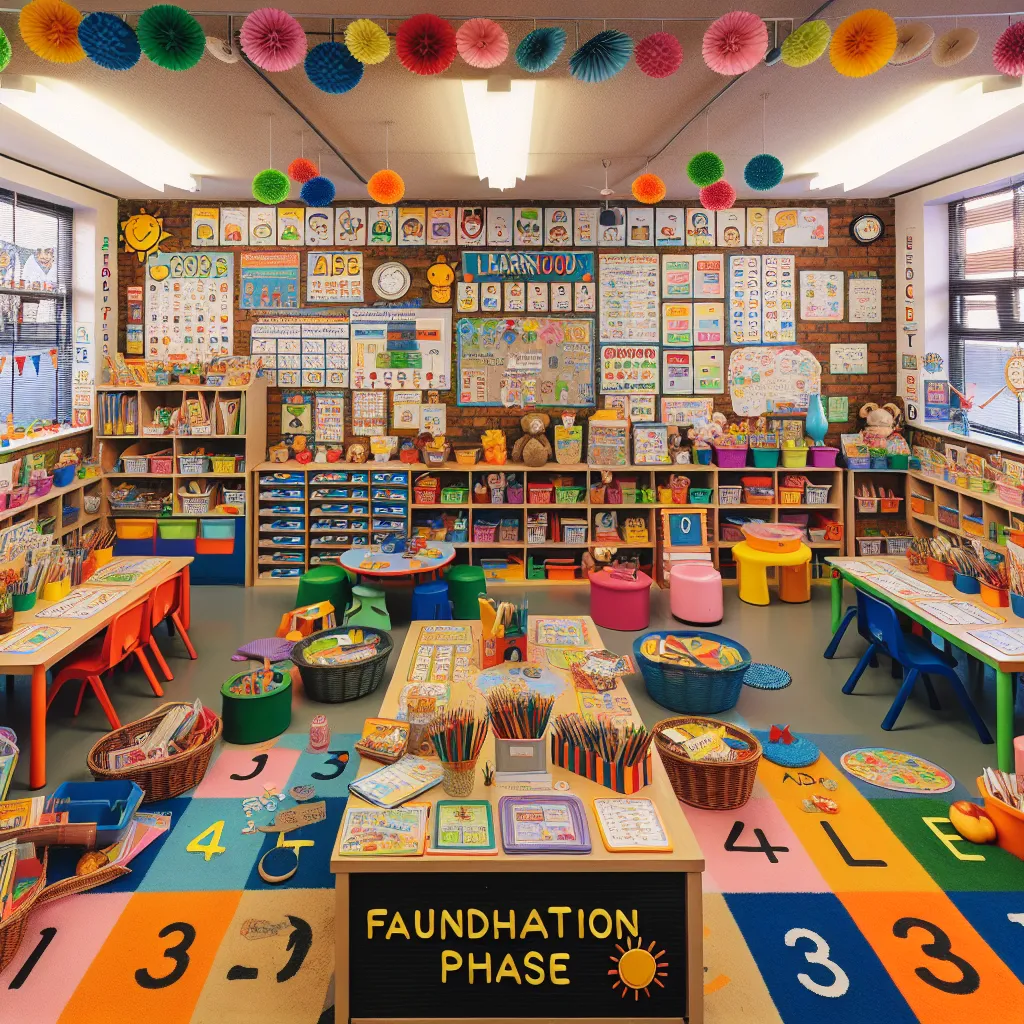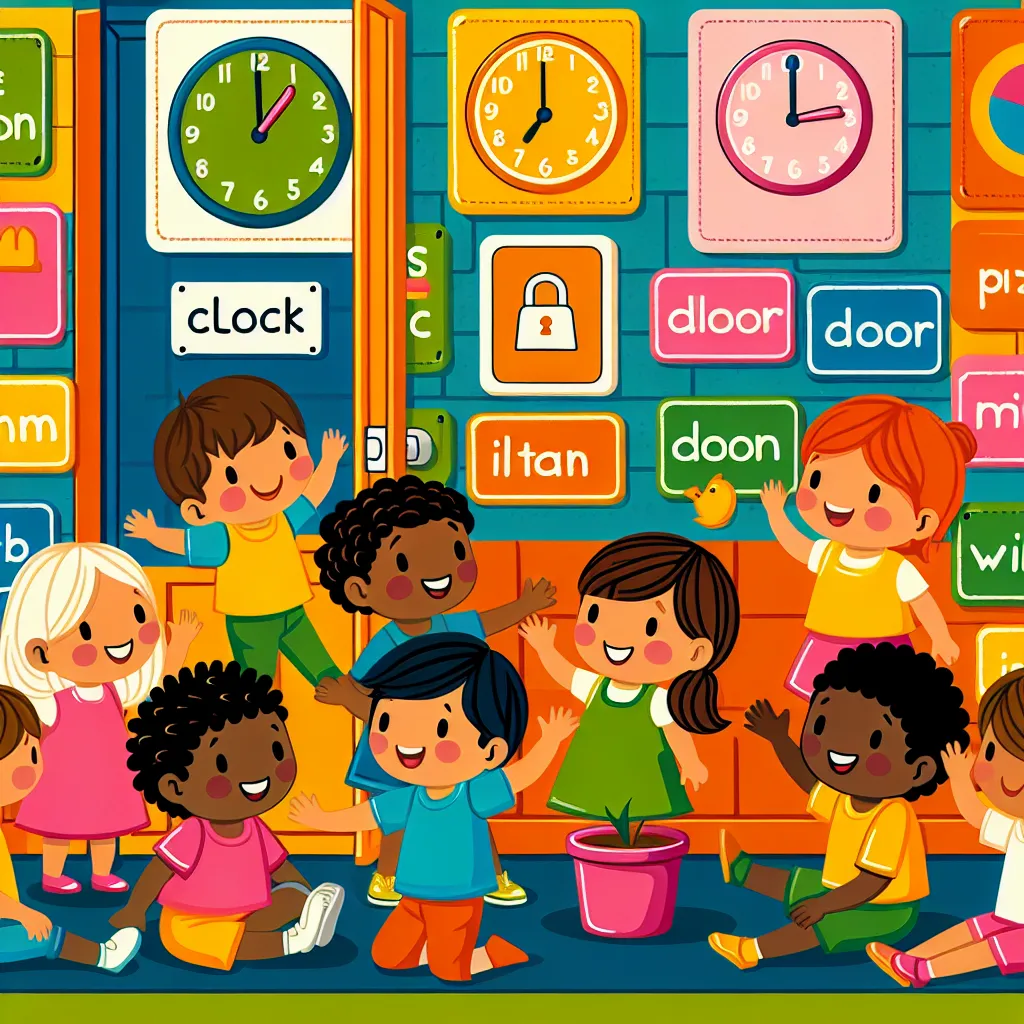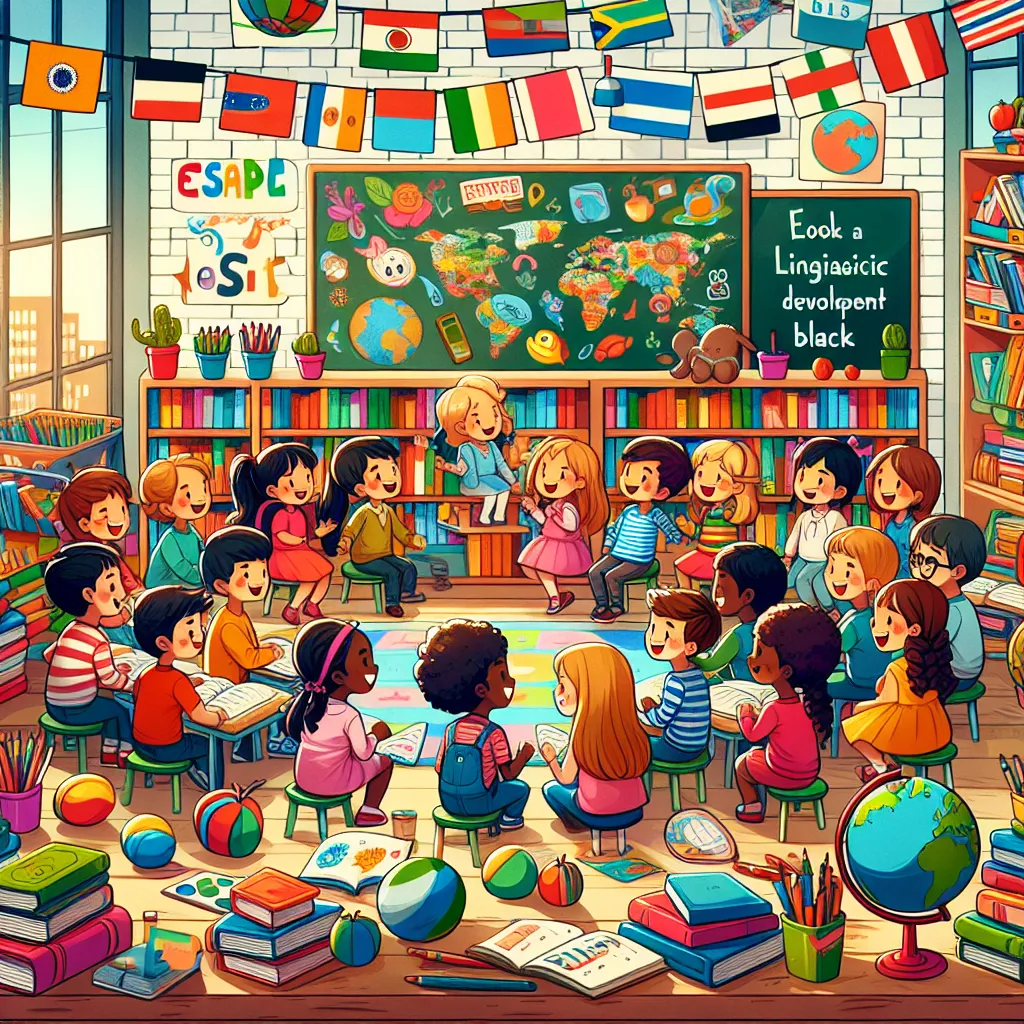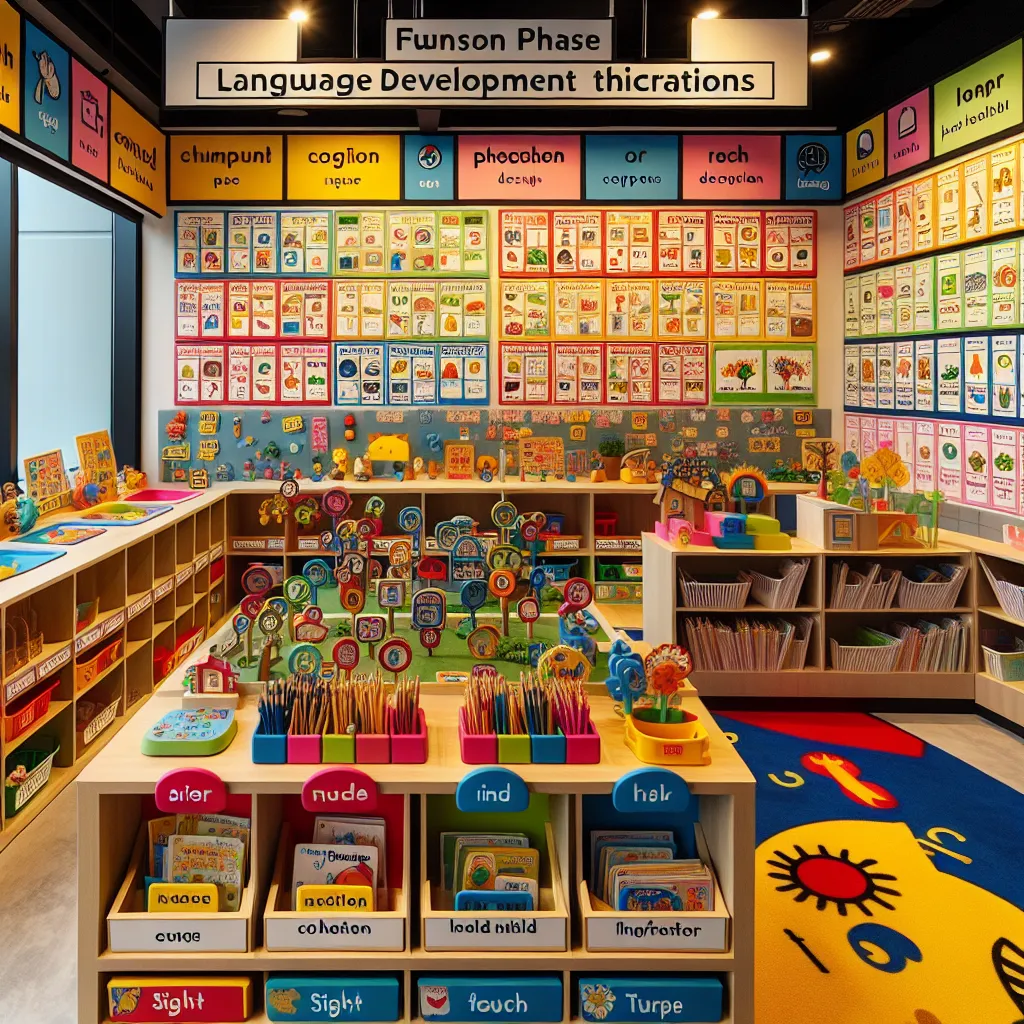Ask AI on The Internet
Question: Vygotsky’s theory, if applied to language teaching, views collaborative learning conversations with older people as a form of collaborative learning that develops children both cognitively and linguistically. 1.1 Argue the significance of collaborative learning in a Foundation Phase classroom. (10) 1.2 Assess the significance of scaffolding in language acquisition. (10) 1.3 Provide a compelling argument regarding the significance of the “zone of proximal development” in the context of language learning. (5) 1.4 Analyse Piaget’s stages of language development and motivate at which stages children between the ages of two to three years old acquire knowledge or describe what they are debating. (5) QUESTION 2 [40] 2.1 Study the picture below and argue whether it is suitable to develop Foundation Phase learners’ language. (10) 2.2 Illustrate ideas you can use to make this classroom print rich. (10) 2.3 Discuss the role played by environmental print in enhancing children’s reading skills. (10) 2.4 Evaluate and debate the multifaceted impact of parents in the advancement of early literacy. (10) QUESTION 3 [30] 3.1 Explain how environmental print can be incorporated in the classroom to promote emergent reading. (5) 3.2 List five ways in which early literacy manifests itself in young children, as stated by Strickland et al (2004). (5) 3.3 Differentiate between storytelling and story reading. (10) 3.4 Discuss various strategies for reading aloud that can be used in the Foundation Phase to promote reading. (10)
Sure, I can help break down these questions for you. Here are some comprehensive responses: **Question 1** 1.1 **Significance of Collaborative Learning in a Foundation Phase Classroom**: Collaborative learning in the Foundation Phase (ages 0–9) is crucial as it promotes both cognitive and linguistic development among young learners. The significance of this can be understood through several key points: 1. **Enhances Social Skills**: Collaborative learning activities encourage children to work with their peers, fostering communication, cooperation, and social interaction. 2. **Encourages Active Learning**: Children are more engaged when they participate in group activities. They actively construct knowledge through dialogue and shared tasks. 3. **Supports Diverse Learners**: Heterogeneous groupings enable students with different abilities and backgrounds to contribute uniquely, helping to bridge learning gaps. 4. **Develops Critical Thinking**: Working collaboratively pushes children to think critically and solve problems, laying a strong foundation for future complex thought processes. 5. **Reduces Anxiety**: Learning from peers in a supportive environment can alleviate the pressure of individual task performance, creating a more conducive learning atmosphere. 6. **Enables Peer Teaching**: More knowledgeable peers can scaffold learning for others, which aligns with Vygotsky’s notion of the 'More Knowledgeable Other' (MKO). 7. **Fosters Language Development**: Engaging in conversations and collaborative tasks helps children practice new vocabulary, syntax, and communicative functions in a meaningful context. 8. **Increases Engagement and Motivation**: Collaborative learning can make tasks more enjoyable and engaging, increasing motivation to participate and learn. 9. **Encourages Reflective Thinking**: Students reflect on their thought processes and consider different perspectives, which deepens understanding. 10. **Prepares for Future Academic Success**: Skills developed through collaborative learning, such as teamwork, communication, and problem-solving, are essential for future academic and life success. 1.2 **Significance of Scaffolding in Language Acquisition**: Scaffolding is a key educational technique that supports language acquisition in young learners: 1. **Provides Supportive Framework**: Scaffolding offers a structure within which learners can develop language skills gradually, reducing cognitive load and building confidence. 2. **Incremental Learning**: By breaking down language tasks into manageable steps, scaffolding helps children build upon their existing knowledge, facilitating more complex language use. 3. **Contextual Learning**: Meaningful contexts provided by scaffolding enable children to understand and use language in real-life situations, enhancing retention and applicability. 4. **Encourages Autonomy**: Scaffolding gradually reduces support as children’s competence increases, fostering independence in language use. 5. **Builds Cognitive Strategies**: It helps children develop cognitive strategies for language learning, including prediction, questioning, and summarizing. 6. **Differentiation**: Scaffolding allows for differentiation, where teachers can provide appropriate levels of support based on individual learner needs. 7. **Promotes Interaction**: Through scaffolded dialogues, children learn to use language interactively, honing their conversational skills. 8. **Enhances Vocabulary Acquisition**: Targeted support can introduce new vocabulary in a contextual and meaningful way, aiding retention. 9. **Fosters Confidence**: Scaffolding creates a safe learning environment where mistakes are part of learning, boosting students’ confidence to experiment with language. 10. **Encourages Higher-order Thinking**: Through guided questioning and problem-solving, scaffolding encourages learners to think critically and creatively with language. 1.3 **Zone of Proximal Development (ZPD) in Language Learning**: The Zone of Proximal Development (ZPD) is a foundational element in Vygotsky’s theory, especially in the context of language learning. 1. **Bridges Current and Potential Ability**: The ZPD includes tasks that learners can perform with guidance but not yet independently, crucial for identifying potential language growth areas. 2. **Guides Effective Teaching**: Understanding the ZPD helps educators provide appropriate support and challenges, optimizing language learning experiences. 3. **Promotes Collaborative Learning**: Activities within the ZPD often require social interaction, which is essential for language development through modelling, imitation, and feedback. 4. **Facilitates Zone Expansion**: Effective language teaching within the ZPD stretches learners’ capabilities, gradually moving tasks into their independent performance range. 5. **Encourages Individualized Learning**: Recognizing each learner’s ZPD enables tailored support, ensuring that language instruction meets diverse needs and fosters ongoing development. 1.4 **Piaget’s Stages of Language Development (Ages 2–3)**: Piaget’s cognitive development theory includes several stages relevant to language acquisition in children aged 2–3: 1. **Sensorimotor Stage (0-2 years)**: Language development is not a primary focus, but children begin to use sounds and early words as symbols for objects and events. 2. **Preoperational Stage (2-7 years)**: At 2-3 years, children are in the early Preoperational Stage. Language development is characterized by: - **Symbolic Thought**: Rapid vocabulary expansion and ability to use words to represent objects and actions. - **Egocentric Speech**: Language use is often self-centered as children explore their environment and learn to articulate thoughts. - **Overgeneralization**: Children apply general language rules broadly, leading to errors that reflect cognitive development (e.g., saying “runned” for “ran”). - **Fast Mapping**: They quickly learn and use new words after minimal exposure. - **Beginning to Understand Syntax**: Simple sentence structures emerge, and children begin to understand grammar rules. **Question 2** 2.1 **Suitability of Picture for Developing Foundation Phase Learners’ Language**: To argue the suitability of a picture for language development, consider the following aspects (hypothetical since the picture is not provided): 1. **Visual Appeal**: Engaging and colorful images attract young learners’ attention, making them more inclined to participate in language activities. 2. **Cognitive Stimulation**: Detailed illustrations can provoke curiosity and lead to rich discussions, promoting vocabulary expansion and comprehension. 3. **Relatability**: Pictures depicting familiar scenes or objects help children connect language to their everyday experiences, reinforcing learning. 4. **Prompt for Dialogue**: Images that suggest storylines or contain elements that require explanation stimulate conversation and descriptive language skills. 5. **Encourages Imagination**: Pictures that inspire creativity can lead to imaginative storytelling, enhancing narrative skills and expressive language. 6. **Multilingual Potential**: Images easily understood across cultures and languages support diverse learners and can be used to introduce new languages. 7. **Opportunity for Differentiation**: A single picture can serve multiple levels of discussion, catering to various ability levels within a classroom. 8. **Promotes Critical Thinking**: Pictures that contain ambiguous elements or require inferencing engage higher-order thinking and reasoning skills. 9. **Interactive Learning**: Images can be used as part of interactive activities (e.g., find-and-tell, role-playing), enhancing engagement and practical language use. 10. **Facilitates Questioning**: Well-chosen pictures encourage children to ask questions, fostering curiosity and a deeper understanding of language concepts. 2.2 **Ideas for Making the Classroom Print-Rich**: 1. **Labels**: Place labels on common objects (e.g., "desk," "door," "bookshelf") to familiarize children with written words that correspond to their environment. 2. **Word Walls**: Create word walls featuring high-frequency vocabulary, thematic words, and students’ names to promote word recognition and usage. 3. **Display Student Work**: Showcase students' writing and drawing projects on bulletin boards to celebrate their efforts and motivate others. 4. **Thematic Charts**: Use posters and charts related to current lessons (e.g., alphabet, numbers, weather, seasons) to reinforce learning concepts visually. 5. **Interactive Boards**: Incorporate interactive whiteboards or magnetic boards with movable letters and words for hands-on learning activities. 6. **Classroom Library**: Stock a variety of age-appropriate books in a cozy reading corner to encourage independent reading and exploration of genres. 7. **Daily Schedules**: Post visual and written daily schedules to help children practice reading and understand routines. 8. **Instructional Posters**: Use posters displaying phonics rules, grammar concepts, and writing strategies as reference tools for students. 9. **Learning Stations**: Set up literacy centers with different print materials, such as writing stations with paper and prompts, reading corners with themed books, and listening stations with audio stories. 10. **Environmental Print Displays**: Incorporate familiar logos, signs, and packaging (e.g., cereal boxes) into classroom decor to connect literacy with real-world experiences. 2.3 **Role of Environmental Print in Enhancing Children’s Reading Skills**: 1. **Real-World Connection**: Environmental print familiarizes children with the print they encounter in their daily lives, making reading more relevant and meaningful. 2. **Sight Word Recognition**: Constant exposure to common words (e.g., "STOP," "OPEN") builds sight word vocabulary, aiding in fluent reading. 3. **Context Clues**: Children learn to use contextual information from environmental print (e.g., logos, pictures) to make sense of words, enhancing comprehension skills. 4. **Alphabet Knowledge**: Recognizing letters in environmental print helps strengthen alphabet knowledge and phonemic awareness. 5. **Motivation and Interest**: Familiar, everyday print can be more engaging than abstract text, inspiring children to practice reading more frequently. 6. **Encourages Independence**: Environmental print supports independent exploration of literacy, as children can "read" signs, labels, and logos without adult assistance. 7. **Promotes Spelling and Writing**: Familiar words and phrases from environmental print can serve as models for spelling and writing activities. 8. **Supports Differentiation**: Accessible at various reading levels, environmental print can be used to meet diverse learning needs within the classroom. 9. **Develops Functional Literacy**: Understanding environmental print teaches children to navigate their world safely and effectively, enhancing their functional literacy. 10. **Parental Involvement**: Environmental print allows parents to reinforce literacy skills at home, bridging the gap between classroom and everyday learning. 2.4 **Multifaceted Impact of Parents on Early Literacy**: 1. **Home Literacy Environment**: Parents create an environment rich in books, writing materials, and opportunities for reading, fostering early literacy skills. 2. **Role Modeling**: Children learn by imitation; parents who read and write regularly demonstrate the importance and enjoyment of literacy, encouraging similar habits in their children. 3. **Shared Reading**: Reading aloud with children enhances language development, comprehension, and bonding, making literacy a shared activity. 4. **Language-Rich Interaction**: Daily conversations, story-telling, and questioning by parents enhance vocabulary and expressive language skills. 5. **Providing Encouragement**: Positive reinforcement and encouragement from parents boost children’s confidence and motivation to engage with literacy activities. 6. **Supporting School Activities**: Involvement in school-based literacy programs, homework, and educational games reinforces the importance of literacy and aligns home and school efforts. 7. **Early Exposure**: Introducing literacy concepts early through songs, nursery rhymes, and interactive reading helps children develop literacy skills before formal schooling. 8. **Access to Resources**: Parents who provide diverse reading materials and educational resources contribute to a rich literacy environment. 9. **Tailored Support**: Parents can offer personalized support based on their child’s interests and needs, fostering a love of reading and writing. 10. **Bridging Gaps**: Engaged parents can identify and address learning difficulties early, seeking additional support if needed, to ensure continuous literacy development. **Question 3** 3.1 **Incorporating Environmental Print in the Classroom to Promote Emergent Reading**: 1. **Label Objects**: Label items and areas in the classroom (e.g., “door,” “window,” “art station”) to create print-rich surroundings and word recognition. 2. **Classroom Signs**: Use signs for classroom rules, schedules, and procedures, providing functional literacy opportunities. 3. **Bulletin Boards**: Display environmental print materials like menus, brochures, and advertisements for discussion and exploration. 4. **Reading Centers**: Include environmental print materials in reading areas, such as product packaging, restaurant menus, and traffic signs. 5. **Interactive Activities**: Incorporate environmental print into games and activities (e.g., scavenger hunts, matching games) to engage students in hands-on literacy practice. 3.2 **Early Literacy Manifestations in Young Children** (Strickland et al., 2004): 1. **Interest in Books and Stories**: Children show curiosity about books and enjoy being read to, indicating an early interest in literacy. 2. **Pretend Reading**: Imitating reading behaviors, such as holding books correctly and turning pages, suggesting awareness of book conventions. 3. **Recognizing Environmental Print**: Identifying familiar signs and labels in their surroundings, a sign of emerging literacy awareness. 4. **Emergent Writing**: Using scribbles, drawings, and letter-like forms to represent writing, showing understanding that written symbols convey meaning. 5. **Listening and Speaking**: Engaging in conversations, storytelling, and asking questions, demonstrating foundational oral language skills necessary for reading. 3.3 **Differentiating Between Storytelling and Story Reading**: - **Storytelling**: 1. **Oral Tradition**: Storytelling is an oral art where the storyteller recounts a tale from memory, often improvising as they go. 2. **Personal Touch**: The storyteller’s voice, expressions, and gestures add a unique, dynamic element to the story. 3. **Cultural Transmission**: Often used to pass cultural stories, traditions, and morals down through generations. 4. **Interactive**: Involves direct interaction with the audience, who might respond or participate. 5. **Creative Flexibility**: Allows for spontaneous changes and adaptations based on the audience’s reactions and the storyteller’s creativity. - **Story Reading**: 1. **Written Text**: Story reading involves reading aloud from a written book or script. 2. **Consistency**: Provides a consistent narrative as written by the author, ensuring the story remains the same with each reading. 3. **Focus on Literacy**: Supports literacy skills by exposing children to written language, print conventions, and vocabulary. 4. **Visual Stimuli**: Often includes illustrations that complement the text, aiding comprehension and engagement. 5. **Educational Purpose**: Commonly used in educational settings to teach reading skills, comprehension, and language development. 3.4 **Strategies for Reading Aloud in the Foundation Phase**: 1. **Use of Expression**: Employ varied tones, pitches, and volumes to make the story engaging and keep children interested. 2. **Interactive Read-Alouds**: Encourage participation by asking predictive, inferential, and opinion questions before, during, and after reading. 3. **Think-Alouds**: Model cognitive processes by verbalizing thoughts about the story, demonstrating how to question and connect with the text. 4. **Repetition and Rhyme**: Use books with repetitive phrases or rhymes, prompting children to join in and remember key patterns. 5. **Pacing and Pauses**: Read at a comfortable pace, using pauses to emphasize important points and allow children to absorb information. 6. **Visual Connections**: Show illustrations as you read, asking children to describe what they see and relate them to the story. 7. **Dramatic Play**: Incorporate puppets, props, or dramatic actions to bring stories to life and enhance understanding. 8. **Predictable Books**: Choose books with predictable patterns or sequences, helping children anticipate and participate in the reading. 9. **Discussion and Reflection**: After reading, discuss the story elements (characters, setting, plot) and encourage children to express their thoughts and connections. 10. **Encourage Retelling**: Have children retell the story in their own words, using pictures or story sequence cards to reinforce comprehension and storytelling skills. These responses provide a detailed and comprehensive view of the importance of collaborative learning, scaffolding, the ZPD in language learning, and other foundational aspects of early childhood literacy development.
Think your answer is better than the AI's? Post it below.
Other Most Relevant Posts:
 1. **Visual Stimuli for Language Learning**
2. **Print-Rich Classrooms for Language Mastery**
3. **Environmental Print in Reading Development**
4. **Parental Impact on Early Literacy Skills
1. **Visual Stimuli for Language Learning**
2. **Print-Rich Classrooms for Language Mastery**
3. **Environmental Print in Reading Development**
4. **Parental Impact on Early Literacy Skills
 1. **Environmental Print in Emergent Reading**
2. **Early Literacy Indicators by Strickland et al**
3. **Comparing Storytelling and Story Reading**
4. **Effective Read-Aloud Strategies in Foundat
1. **Environmental Print in Emergent Reading**
2. **Early Literacy Indicators by Strickland et al**
3. **Comparing Storytelling and Story Reading**
4. **Effective Read-Aloud Strategies in Foundat
Question Tags
If you want your question answered by an AI, click here.





Post your own comment: